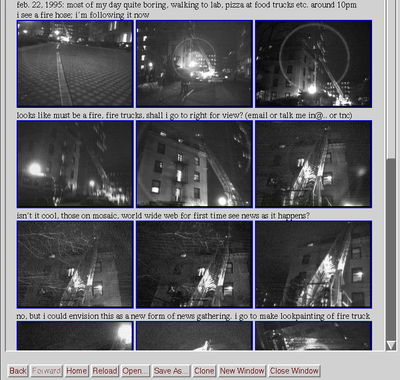Mobile journalism
Mobile journalism is an emerging form of new media storytelling where reporters use portable electronic devices with network connectivity to gather, edit and distribute news from his or her community.[1]
Such reporters, sometimes known as mojos (for mobile journalist), are staff or freelance journalists who may use digital cameras and camcorders, laptop PCs, smartphones or tablet devices. A broadband wireless connection or cellular phone network is then used to transmit the story and imagery for publication.[2][3] The term mojo has been in use since 2005, originating at the Fort Myers News-Press and then gaining popularity throughout the Gannett newspaper chain in the United States.[4]
Some key benefits of mobile journalism in comparison to conventional methods include affordability, portability, discretion, approachability, and the ease of access for beginners[5].
History

One of the first instance of mobile journalism recorded is from wearable technology pioneer Steve Mann as a feature in a personal visual assistant in he designed, he identified himself as a roving reporter. [6]
In the beginning, he faced concerns from the press about privacy. He responded by writing on The Tech of MIT on July 24, 1996 a guest column "Wearcam Helps Address Privacy Issue". In the column, he stated that he was wearing his experimental eye glass to bring awareness to the huge and growing number of surveillance cameras that were watching over citizen's activities. He also stated in the article that he "exercises deference to others, " many of the photos he took were "architecture details, experiments in light and shade, posed shots done at the request of those in the picture". [7]
Every year, hundreds of mobile journalists attend "Mojo" conferences, Mojocon, or MojoFest, which are often organized in association with RTE, the national public services broadcaster of Ireland.
Editors at AJ+, a digital outlet form Al Jazeera, use mobile journalists in their video news coverage [8]
See also
Published Books
- Stassen, Bjorn; Vellinga, Wytse (2018). Mobile Storytelling. Hamburg: Amazon.
- Montgomery, Robb (2018). Smartphone Video Storytelling. New York & London: Routledge Press (Taylor and Francis Group).
- Podger, Corinne (2018). The Mobile Journalism Manual: The Guide for Reporters and Newsrooms. Singapore: Konrad Adenauer Stiftung.
- Adornato, Anthony (2017). Mobile and Social Media Journalism: A Practical Guide. Los Angeles and London: SAGE/CQ Press.
- Burum, Ivo; Quinn, Stephen (2016). Mojo - The Mobile Journalism Handbook. New York & London: Focal Press.
- Burum, Ivo (2016). Democratizing Journalism through Mobile Media: The Mojo Revolution (Routledge Research in Journalism). New York & London: Taylor and Francis.
- Montgomery, Robb (2014). A Field Guide for Mobile Journalism. Interactive: Visual Editors.
- Quinn, Stephen (2009). Mojo - Mobile Journalism in the Asian Region (PDF). Singapore: Konrad-Adenauer-Stiftung. Retrieved 29 Jan 2010.
References
- ↑ Richardson, Allissa. "Mobile Journalism: A Model for the Future". Diverse Issues in Higher Education. Cox, Matthews and Associates, Inc. Retrieved January 9, 2013.
- ↑ Marymont, Kate (2 October 2007). "MoJo a Go-Go". Quill: 18–21. ISSN 0033-6475.
- ↑ Marymont, Kate (10 February 2006). "How They Did It: Fort Myers' "mojo" journalists search out news at the neighborhood level, identify community contributors". Gannett News Watch. Retrieved 22 May 2008.
- ↑ Martyn, Peter H (1 April 2009). "The Mojo in the Third Millenium: Is multimedia journalism affecting the news we see?". Journalism Practice. 3 (2): 196–215. doi:10.1080/17512780802681264. Retrieved 27 Feb 2009.
- ↑ Podger, Corinne. "Benefits of going 'mojo'". Mobile Journalism Manual: The Guide for Reporters and Newsrooms.
- ↑ "Joi Ito's Moblogging, Blogmapping and Moblogmapping related resources as of 1/18/2003 18:00". wearcam.org. Retrieved 2018-08-03.
- ↑ "Wearcam Helps Address Privacy Issue - The Tech". tech.mit.edu. Retrieved 2018-08-03.
- ↑ "How AJ+ reported from Baltimore using only mobile phones". Poynter. Retrieved 2018-09-03.